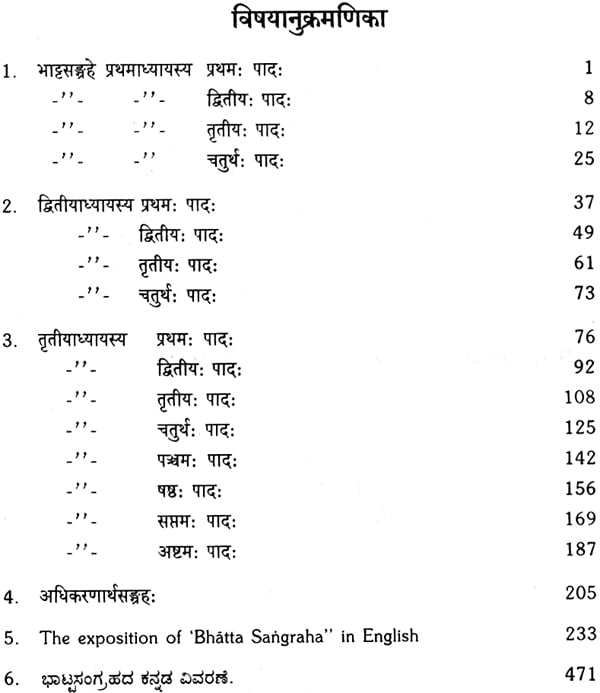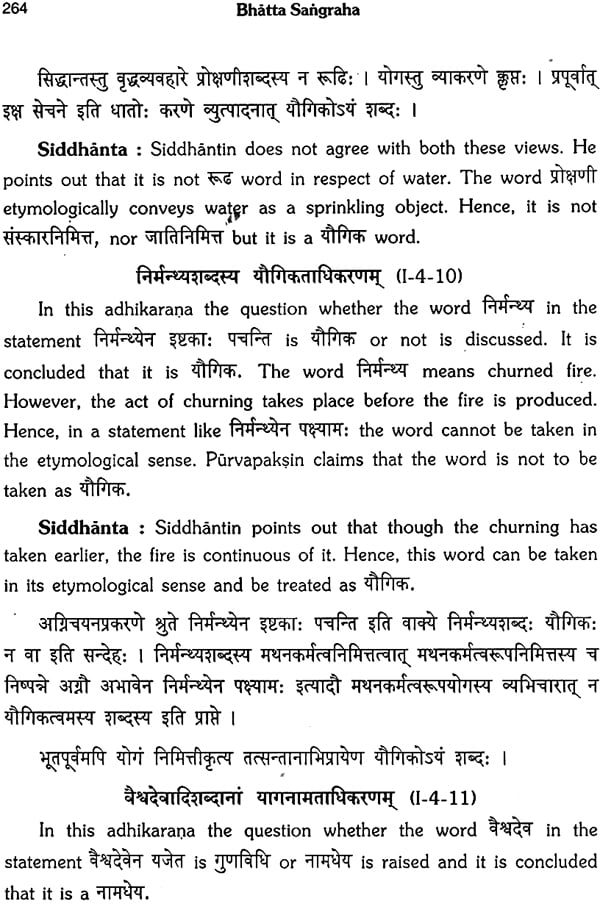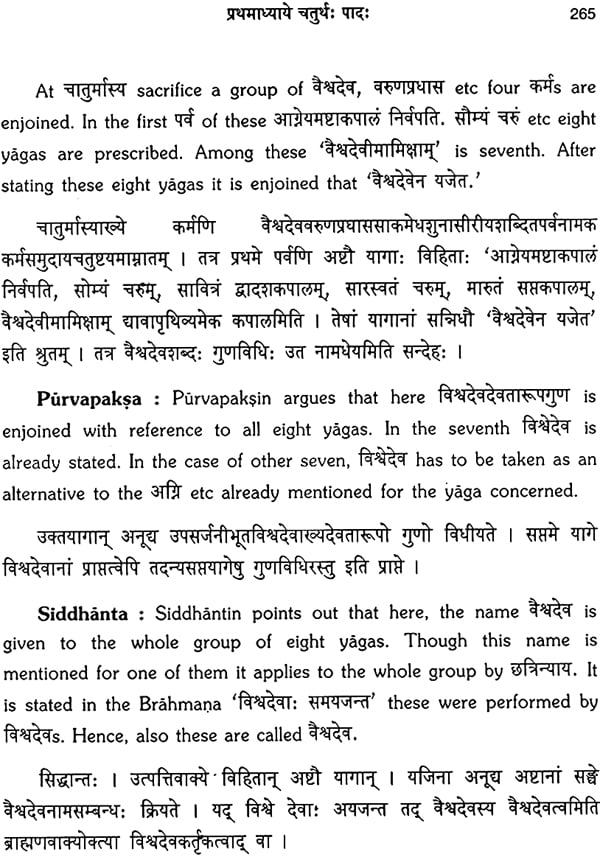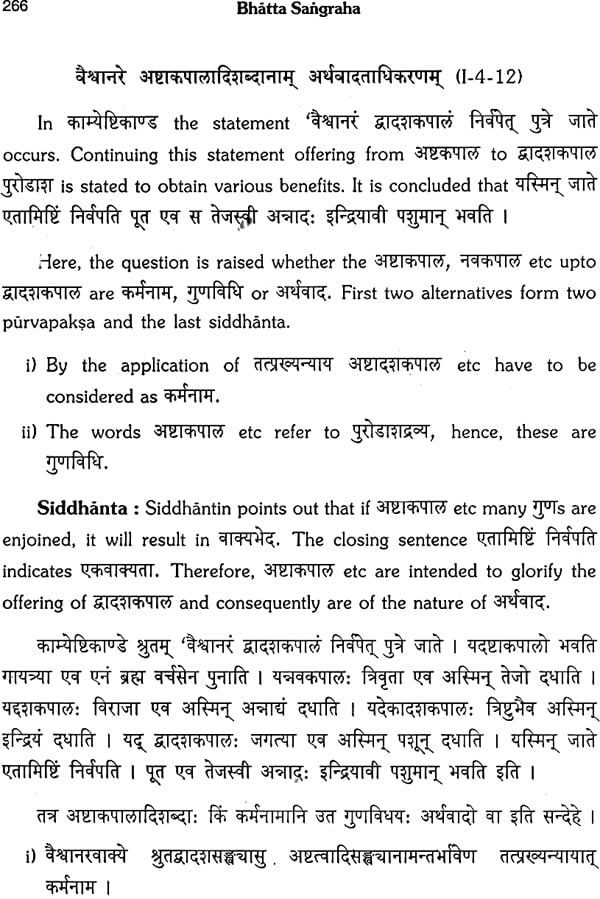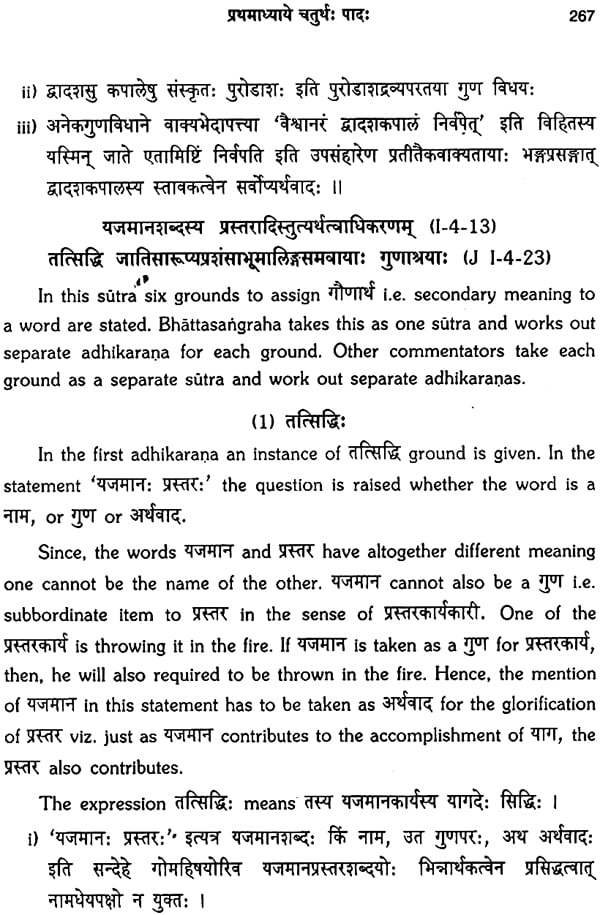
भाट्टसंग्रह: Bhatta Sangrah (Set of 3 Volumes)
Book Specification
| Item Code: | NZG255 |
| Author: | Prof. K. T. Pandurangi |
| Publisher: | DVAITA VEDANTA STUDIES & RESEARCH FOUNDA |
| Language: | Sanskrit Only |
| Edition: | 2004 |
| Pages: | 1645 |
| Cover: | Hardcover |
| Other Details | 10.0 inch X 7.5 inch |
| Weight | 3.30 kg |
Book Description
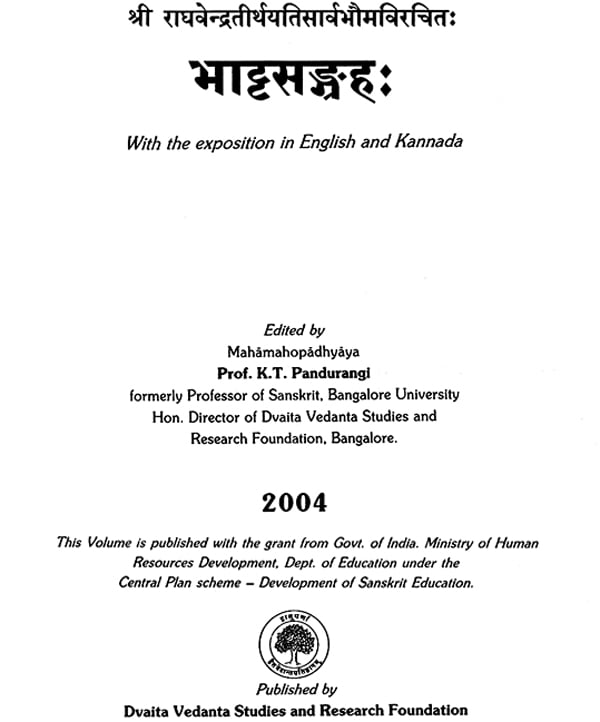
Bhatt Sangraha of Sri Raghavendra tirtha is the unique commentary on the entire Jaimini Sutras. भाट्टसंग्रह and जैमिनीयन्यायमालाविस्तर are the earlier commentaries on Jaimini Sutras. शास्त्रदीपिका is very elaborate while जैमिनीयन्यायमाला is very brief. It gives पूर्वपक्ष and सिध्दान्त in one or two sentences. भाट्टसंग्रह gives a simple and clear narration of the two sides and clearly brings out the conclusion. Wherever there is variation between the भाष्य and वार्तिक, भाट्टसंग्रह gives the interpretation of the two separately stating as भाष्यरित्या and वार्तिकरीत्या. Another feature of भाट्टसंग्रह is that the important मन्त्र are fully quoted and the obscure terms therein are fully explained. This work was greatly honoured by the great scholar Nilakanta Dikshit of Tanjore and the Tanjore Royal palace honoured it by arranging a procession on elephant.
Prof. Pandurangi has added an exposition in English and Kannada to help the modern scholars.
Publication of this work is planned in three volumes. The present volume contains the first three chapters.
It is hoped that this work will be useful for the Research Scholars of पूर्वमीमांसा and वेदान्त
Bhatta Sangraha of Sri Raghavendra Swamiji is a unique commentary on entire Jaimini Sutras.
Mimamsa Darsana is one of the six systems of India Philosophy and is very ancient one. The terms ‘Mimamsa’, ‘Mimamsante’ occur in Brahmanas and refers to the discussions of meaning of Vedic passages dealing with the performance of sacrifices. In due course such discussions developed into a systematic sastra and Jaimini wrote these sutras. There are two thousand and seven hundred sutras arranged in twelve chapters. The chapters normally have four padas but chapters third, sixth and tenth are Sarabhapadas or have eight padas. There are about thousand adhikarans or topics of discussion.
According to our tradition Jaimini was a disciple of Krisna-Dvaipayana Vedavyasa and lived at the close of Dvapara (31,000 B.C). However, modern scholars assign him to 3rd Century B.C.
The purpose served by Purvamimamsa is three-fold:
1. Evolving the rules of interpretation or nyayas for the interpretation of vedic-passages. Therefore, this sastra is called Vakyasastra.
2. Giving authoritative rulings on sacrificial matters such as adhikara, anga, atidesa, uha, badha, tantra etc. and fixing the correct procedure and the nature of sacrifices. For this reason it is called Karma-Mimansa.
3. It is also a Darsana or one of the philosophical systems and hence discusses Pramana and Prameyas. In this connection, the contributions made by Purvamimamsa for the discussion of Vedapauruseyatva and Svatahpramanya are very valuable. Its concepts of atman, moksa etc. are peculiar and are eclipsed by the great heights achieved in Vedanta on these concepts. Keeping these discussions in mind this system is considered as a Darsana and called Mimamsa Darsana.
Jaimini refers to certain earlier thinkers in his Sutras such as Badari, karshnajani, Atreya, Aitisayana and Kamukayana. The surmise of the modern scholars that these are likely to have written similar sutras which are lost to us has not sufficient evidence.
Three Vrttis or short commentaries seem to have been written on Jaimini sutras by Baudhayana, Upavarsa and Bhavadasa. These are not available to us. The extracts of upavarsa’s Vrtti are incorporated in Sabara’s Bhasya. The first two seems to have written their Vrtti both on Jaimini-sutras and Badarayana-Sutras. Sabara wrote his Bhasya during 200 A.D. Bhartrmitra’s (400 A.D.) commentary on this was written before Kumarila. It is not available. Kumarila (620-703 A.D.) was a versatile scholar who wrote three commentaries i.e. Slokavartika, Tantravartika and Tup-tika on different portions of Sabara Bhasya. The main object of Slokavartika was to offer a strong criticism of Buddhist doctrines, and the remaining two commentaries were intended for a detailed exposition of Jaimin’s Sutra and Sabara’s Bhasya. With Kumarila commenced the Bhatta School of Purvamimamsa. Prabhakara’s (650-700 A.D.) Brihati or Vivarana started Prabhakara School. Murari’s third School did not develop further. Umveka, Sucharita-Misra, Parthasarathi, Bhavadeva, Madhavacharya, Bhatta Someshwara and khanda Deva are important writers of Bhatta School, while Salikantha, Bhavantha, Nandisvara etc. are important writers on Prabhakara side.
The present work ‘Bhatta Sangraha’ of Sri Raghavendra Swamiji is a direct commentary on entire Jaimini-Sutras. Sastradipika and Jaiminiya-nyayamala were earlier such commentaries on Jaimini Sutras while Bhattadipika of Khandadeva (1600-1665 A.D.) is contemporaneous to Sri Raghavendra Swamiji’s work.
Sri Raghavendra Swamiji neatly arranges the topic of each adhikarana under: 1. Sangathi (context and connection). 2. Vishaya (topic and the passage setting the topic). 3. Samsaya (doubt or alternate possibilities) of interpretation. 4. Purvapaksa (prima-facie view). 5. Siddhanta (Final view).
Discussing each topic under these heads he mentions the phala or prayojana from both Purvapaksa and Siddhanta points of view. This brings out the full significance of the discussion and the siddhanta view. At the close he gives word by word interpretation of key Sutras of purvapaksa and siddhanta. By this method the gist of the adhikarana is made so clear that nothing remains ambiguous. This method is not new to those scholars who have studied Tatvaprakasika of Sri Jayatirtha and Tantradipika of Sri Raghavendra Swamiji himself on Brahma Sutra. Here is a combination of methods adopted in these two works. As for the working out of Sangati he is guided by the methods of Tatparyachandrika of Sri Vyasaraja.
Both Sastradipika and Bhattadipika mention Sangati. But these two works do not explicitly work out sangati at the commencement of each adhikarana. In some adhikaranas sangati is mentioned, in others it is implied. But in Bhatta-Sangraha Sangatis such as Akshepiki, Apavadiki, Prasangiki and Pratyudharana are clearly worked out. This clearly shows the difference as well as the connection of the nyayasa or rulings given in the earlier adhikarana and the adhikarana under discussion and unfolds the intricacies of interpretations and rules of interpretations. Similarly adhyaya and pada sangatis are also clearly worked out. In respect of Vishaya-vakyas, there is a broad agreement between Sastradipika and Bhattasangraha. However, in a few cases Bhatta-Sangraha points out the divergence between Bhasya and Sastradipika, and follows Bhasya. Sastradipika is very elaborate in its treatment of topics while Bhatta-Sangraha is to the point. It is not a mix-up of Vadagrantha and Vyakhyana-grantha like Sastradipika; nor it is very brief as Jaiminiya Nyayamala. While Nyaya-mala just mentions Purvapaksa and siddhanta in one or two sentences the Bhatta-sangraha gives a simple and clear narration of the two sides and clearly brings out the conclusion. A clear setting of word by word meaning of key sutras of each adhikarana is a great help to the correct grasping of their meanings. Wherever, there is variation between the views of Bhasyas and Vartika, Bhatta Sangraha gives the interpretation of the two separately, stating as ‘Bhasyaritya’ and ‘Vartikaritya’. Similarly Vrittikara’s views are also separately stated. In a few adhikaranas where alternate interpretations are possible and adopted in the Purvamimamsa tradition, the two interpretations are clearly and separately given as prathama varnaka and dvitiya varnaka. Another feature of Bhatta Sangraha is that the important mantras are fully quoted and obscure terms therein are explained. Similarly technical terms are also fully explained. Karikas from Slokavartika are quoted in the relevant context.
While Bhattadipika differs from Bhasya here and there, and sets its own views, Bhatta-Sangraha properly explains those portions and finds no difficulty in understanding Bhasya. Thus Bhatta Sangraha offers simple, clear and authoritative interpretations to Jaimini- sutras and is a valuable work of Purvamimamsa.
Those who are familiar with the works of Sri Jayatitha, Sri Vyasaraja, Sri Vijayindra and the two important works i.e. Parimala and Chandrikaprakasa of Sri Raghavendra himself know well, how useful is the study of Purvamimamsa as an aid to the study of Vedanta. They also know the erudite Purvamimamsa scholarship of these authors. The publication of Bhatta sangraha will enhance such aid of Purvamimamsa further. Both the scholars of purvamimamsa and Vedanta will immensely benefit by the publication of this work. No wonder this work was greatly honoured by the great scholar NIlakantha Dixita of Tanjore and the Tanjore royal palace honoured it by arranging a procession on elephant. Gurugunastava of Sri Vadindra records this occasion.
With a view to make the contents of such a valuable work available to modern scholars the summary in English is also added. It is hoped that the Research Scholars and students will utilize this work for their study and research in Purvamimamsa and Vedanta.
